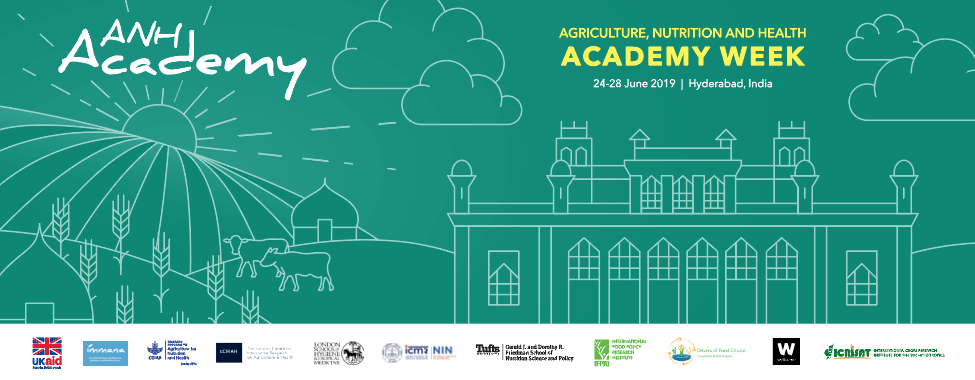
Three, 10-minute abstract-driven presentations.
Speakers and Presentations:
- Chair: Richmond Aryeetey, University of Ghana
-
Tchègoun Michel, University Of Parakou, Benin
Adoption and impact of climate-smart innovation on household productivity, food and nutritional security in Benin
Slides/ Recording -
Chris Vogliano, Massey University, New Zealand
Can biodiverse food systems reverse the rise of chronic diseases while providing climate change resilience in the Small Island Developing States?
Slides/ Recording -
Mulia Nurhasan, Center for International Forestry Research (CIFOR)
Food consumption patterns and changes in Indonesia’s forested and deforested areas
Slides/ Recording -
Q&A
Recording
Abstracts:
Adoption and impact of climate-smart innovation on household productivity, food and nutritional security in Benin
Tchègoun Michel, University Of Parakou, Benin
Introduction: In recent years, studies have shown the primary role of innovation in African agricultural development. Thus, some climate-smart innovations like drought-tolerant maize (DTM) varieties were disseminated in Benin to increase productivity, food security, nutritional status, and decrease poverty. Many studies have shown that the adoption of innovations can increase agricultural productivity, overcome poverty, and improve food security. However, other studies have shown the opposite conclusions. Accordingly, there is a need for more research to contribute to the resolution of this contradiction in the literature.
Methods: This paper examines the impact of adoption of DTM varieties on productivity, household food security, and nutritional status, using country-wide cross-sectional data of about 518 maize farming households in Benin. The study uses a mixed methods approach based on both qualitative and quantitative techniques. The qualitative component consists of focus group discussions and in-depth interviews with various key stakeholders. The quantitative component consists of building a valid counterfactual by using endogenous switching regression to measure the impact of adoption of DTM varieties packages. The paper used respectively per capita expenditure, food per capita expenditure, Household Dietary Diversity Score (HDDS), Household Food Consumption Score (FCS), Household Food Insecurity Access Scale (HFIAS), and anthropometric indexes as outcome indicators of food security and nutritional status and yield as a productivity outcome indicator. To identify the causal effects of DTM variety adoption on productivity, food security, and nutritional status, three instrumental variables were used. Significant differences in socio-economic and demographic characteristics between adopters and non-adopters of DTM varieties were found. To control for such differences and allow a causal interpretation of the real effect of DTM varieties adoption, we have estimated the Average Treatment Effect.
Findings: The selection equation stands for DTM variety adoption drivers have shown that experience of growing maize (years), membership in an association or producer's cooperative, number of poultry holding, total of value of farm assets (in FCFA), the presence of market in the village and special place of selling maize, the use of fertilizer, the quantity of fertilizer used (kg), the level of head of household income, and the distance from house to demonstration farm were negatively and significantly associated with the probability of the adoption of DTM varieties. As the impact result, this paper found that the adoption of DTM varieties does not significantly improve the productivity of adopter households but increases total household spending and their level of dietary diversity in general food and nutritional security. Furthermore, one of the exciting results of our study is that because of the adoption of DTM varieties, households significantly reduce expenditures on food purchases by 15.29 percent. Indeed, DTM adoption significantly increased per capita expenditure, HFIAS, HDDS, Household FCS, and body mass index by 11.19, 50.93, 11.55, 6.14 and 12 percent, respectively.
Conclusions: By conducting our study on the impact of DTM variety adoption on household productivity, food security, and nutritional status in Benin, we contribute to the existing literature on climate-smart innovations. Our findings point out that DTM varieties can play an essential role in fighting food insecurity in Benin. Furthermore, this paper generates evidence on the effects of the DTM variety packages through the rigorous impact evaluation approach and the results will be useful to inform other welfare-related initiatives beyond Benin.
Can biodiverse food systems reverse the rise of chronic diseases while providing climate change resilience in the Small Island Developing States?
Chris Vogliano, Massey University, New Zealand
Introduction: Indigenous food systems of Pacific Island countries contain vast genetic, biological, and cultural diversity. Unfortunately, globalization is fueling a nutrition transition away from local and traditional foods in favour of imported foods, leading to a dramatic rise in non-communicable diseases. Nine of the ten most obese countries in the world are located in the Pacific Islands. Additionally, climate change is increasingly threatening the food and nutrition security of these islands. We aimed to assess how the nutrition transition away from traditional, biodiverse foods and towards imported foods is influencing the health of rural Solomon Islanders.
Methods: Mixed methods research to assess indigenous Solomon Islanders’ diet quality and diversity (Baniata, Rendova Island) through participatory focus group discussions (n=85), repeat multiple-pass 24-hour household dietary recalls (n=30), nutrition surveys, and anthropometric measurements (height, weight, BMI, and body fat percentage). Diet surveys assessed the diet quality, food species and variety diversity, and sourcing of each ingredient. Household food insecurity levels were also assessed.
Findings: Diets of the villagers have been shifting away from traditional varieties of foods in favour of imported and ultra-processed foods. Shifts have occurred due to introductions of processed foods by missionaries (1920s), soldiers from World War II (1940s), and loggers (1990s). The most dramatic changes in the diet have occurred within the past two decades. These transitions are understood to bring increased rates of non-communicable diseases. Over 60% of participants were overweight or obese, and the average body fat percentage was 31%. Despite having access to a wide variety of biodiverse foods, diet patterns are significantly reliant on ultra-processed and imported foods such as white rice, taiyo (canned tuna), biscuits, sugar, and sugary drinks. Diet quality is low in protein (80% of EAR), vitamin A (47%), iron (50%), calcium (38%), and thiamine (51%). However, those who consumed a wider range of biodiverse foods had a significantly lower body fat percentage, and an increased consumption of essential nutrients.
Conclusions: Particular varieties of traditional foods in the Solomon Islands are excellent sources of missing essential nutrients in Pacific Islanders’ diets. Unfortunately, many of these foods are neglected and underutilized species (NUS). Leveraging the power of nutrient-dense, locally adapted, biodiverse foods can help mitigate malnutrition and food security while providing a measure of resilience against some of the adverse impacts of climate change. Repeating this research in several indigenous villages can help determine nutrition-sensitive agricultural policies and nutrition interventions that consider the health of both people and the planet.
Food consumption patterns and changes in Indonesia’s forested and deforested areas
Mulia Nurhasan, Center for International Forestry Research (CIFOR)
Introduction: Indonesia, like much of the rest of the world, is undergoing a modernization of diets. Major shifts in dietary behaviors are resulting in increased consumption of refined carbohydrates, added sweeteners, and animal source foods, and decreased consumption of legumes, vegetables, and fruits. This change is coinciding with rapid deforestation and transformation of Indonesian landscapes. Previous studies have found that forest cover is associated with dietary diversity and nutritional status. This study explores the possible link between Indonesian forest status at regency level and food consumption change between 2008 and 2017.
Methods: Using available data from the Global Forest Watch website, we selected the 50 regencies with the most deforestation and the 50 regencies with the least deforestation. Using two rounds of Indonesian National Socio-economic Survey (SUSENAS) data from 2008 and 2017 on weekly household food consumption, we explored differences in food consumption patterns between these two groups and how this has changed over the time period under consideration. Food groups included: staple foods (rice-based, wheat-based, and others), animal source foods (fresh fish, fresh meat and organ, fresh avian, dairy, and eggs), plant-based foods (fresh legumes, green leafy, vitamin-A rich, other, and total vegetables and fruits), beverages (bottled water, instant caloric beverages, ready-to-drink non-alcoholic caloric beverages, total caloric beverages), home-use ingredients (sugar, salt, MSG, instant spices), processed foods (preserved fish, meat, legumes, instant noodles) and tobacco and alcoholic beverages.
Findings: We found that households in forested and deforested areas are reducing their consumption of rice and other staple foods, towards more wheat-based foods. Consumption of green leafy vegetables, total vegetables, fresh nuts, and legumes decreased in both forested and deforested areas, but consumption of processed legumes, vitamin A-rich vegetables and fruits increased in both forested and deforested areas. Consumption of total fruit increased in forested areas, but decreased in deforested areas. Consumption of fresh ruminant meat decreased in both forested and deforested areas, but consumption of other animal source foods (fish, avian, eggs, and milk) increased in both forested and deforested areas. Consumption of sweet foods, caloric beverages, ready-to-eat instant noodles, savory snacks, and fried fritters increased in forested and deforested areas, while consumption of sugar and salt decreased. Consumption of tobacco increased in forested and deforested areas. Although the trends are similar, the consumed amounts of wheat-based staples, caloric beverages, sugar, salt, instant ingredients, instant noodles, and tobacco in 2017 were higher in deforested areas than in forested areas. Consumption of other staples, milk, green leafy vegetables, vitamin A-rich vegetables and fruits, total vegetables, and total fruits, were higher in forested areas than deforested areas.
Conclusions: Our findings suggest that a modernization of diets is happening all over Indonesia. However, for both 2008 and 2017, households in areas with more intact forest (i.e., less deforestation) consumed better quality diets in several aspects compared to those living in areas with more rapid deforestation. These results are only associations and cannot be interpreted as causal at this stage; however, they point to relationships that are worthy of further exploration. Deforestation may bring higher incomes and other attributes of development, but it also seems to be associated with some of the negative dietary attributes of more modern lifestyles.


